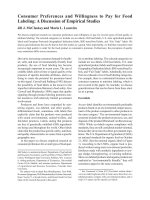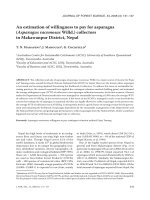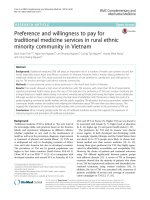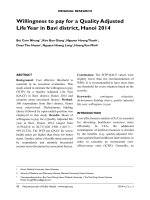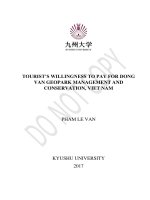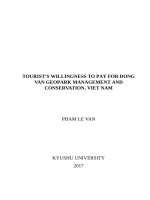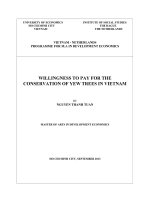Willingness to pay for a group and an individual version of the lifestyle integrated functional exercise program from a participant perspective
Bạn đang xem bản rút gọn của tài liệu. Xem và tải ngay bản đầy đủ của tài liệu tại đây (726.5 KB, 7 trang )
Gottschalk et al. BMC Public Health
(2022) 22:1934
/>
BMC Public Health
Open Access
RESEARCH
Willingness to pay for a group and an
individual version of the Lifestyle-integrated
Functional Exercise program from a
participant perspective
Sophie Gottschalk1*, Hans-Helmut König1, Michael Schwenk2,6, Corinna Nerz3, Clemens Becker3, Jochen Klenk3,4,5,
Carl-Philipp Jansen3,7 and Judith Dams1
Abstract
Background Perceived benefits of intervention programs from a participant perspective can be examined by
assessing their willingness to pay (WTP). Aiming to support decision-makers in their decision to implement a fall
prevention program, this study examined (1) the WTP for a group-based and an individually delivered fall prevention
program, (2) which factors influence WTP, and (3) whether the WTP exceeds the intervention costs.
Methods WTP was elicited using Payment Cards from 237 individuals who participated in a randomized noninferiority trial (LiFE-is-LiFE) comparing a group version of the Lifestyle-integrated Functional Exercise program (gLiFE)
with the individually delivered version (LiFE). Linear regression models were used to examine factors associated with
WTP. The net benefit for (g)LiFE was calculated as the difference between WTP and intervention costs, assuming
different scenarios of intervention costs (varying group sizes of gLiFE) and hypothetical subsidy levels by a payer (€0,
€50, or €75).
Results The mean WTP was €196 (95% CI [172, 221]) for gLiFE and €228 (95% CI [204, 251]) for LiFE. In the linear
regression model, WTP was significantly associated with delivery format (−€32, 95% CI [− 65, − 0.2], for gLiFE) and net
household income (+ 68€, 95% CI [23, 113], for ≥€3000 compared to <€2000). The net benefit for gLiFE was positive
in most cases. Due to higher intervention costs of LiFE compared to gLiFE (€298 vs. €113), the net benefit for LiFE was
negative for the majority of the sample, even at a subsidy of €75.
Conclusion The results provide insight into how valuable the interventions are perceived by the participants and
thereby may be used by decision-makers as complement to cost-effectiveness analyses. WTP for both programs was
generally high, probably indicating that participants perceived the intervention as quite valuable. However, further
research is needed on the WTP and net benefit of fall prevention programs, as results relied on the specific context of
the LiFE-is-LiFE trial.
*Correspondence:
Sophie Gottschalk
Full list of author information is available at the end of the article
© The Author(s) 2022. Open Access This article is licensed under a Creative Commons Attribution 4.0 International License, which permits use,
sharing, adaptation, distribution and reproduction in any medium or format, as long as you give appropriate credit to the original author(s) and
the source, provide a link to the Creative Commons licence, and indicate if changes were made. The images or other third party material in this
article are included in the article’s Creative Commons licence, unless indicated otherwise in a credit line to the material. If material is not included
in the article’s Creative Commons licence and your intended use is not permitted by statutory regulation or exceeds the permitted use, you will
need to obtain permission directly from the copyright holder. To view a copy of this licence, visit The
Creative Commons Public Domain Dedication waiver ( applies to the data made available
in this article, unless otherwise stated in a credit line to the data.
Gottschalk et al. BMC Public Health
(2022) 22:1934
Page 2 of 9
Keywords Willingness to pay, Patient preferences, Participant perspective, Contingent valuation method, Fall
prevention, Physical activity promotion
Introduction
In the context of demographic change, the development
of effective intervention programs to promote health into
old age has become a priority in societies with an increasing population of older people. Besides clinical effectiveness, the (widespread) implementation of a program also
depends on available resources, on whether the benefits
of the program outweigh the costs associated with the
implementation, and on who bears the costs of the program. Depending on the perspective, different benefits
and costs are of relevance when deciding in favor of or
against the implementation of a program. In economic
analyses of healthcare programs, a societal or payer’s
perspective is frequently adopted, assuming that intervention costs are (at least partly) covered by the state or
a health insurer [1]. However, health and well-being are
also perceived as individual responsibility and hence can
be seen as a good that people are willing to invest into.
According to welfare economic theory, the benefits of a
good or service are reflected in the form of willingness to
pay (WTP) – the maximum amount of money an individual is willing to give up for the good or service. Thus,
WTP is a concept that can be used to assign a monetary
value to a good. Thereby, WTP goes beyond health and,
unlike, for example, quality-adjusted life years (QALYs),
which are frequently being used as effect measure in
economic evaluations, does not restrict participants to
express their preferences on pre-specified dimensions [2,
3]. Knowing the strength of a preference, aka how much
people would be willing to pay, could also be relevant
from a payer’s perspective who may opt for a cost subsidy
rather than full coverage of an intervention.
WTP for healthcare interventions is frequently captured using stated preference methods, which can be
classified into direct (e.g., payment cards) and indirect (e.g., discrete choice experiments) methods [4]. In
indirect methods, individuals are typically presented
with several intervention options that differ in, e.g., the
intervention characteristics, expected effects, and price.
Participants are then asked to choose their preferred
intervention option. In direct methods, on the other
hand, individuals’ WTP is determined by directly asking how much individuals would be willing to pay for an
intervention. When collecting WTP data from participants of a clinical trial after completing the intervention,
the stated WTP is assumed to reflect their individual
perception of benefits, which may go beyond clinically
visible effects such as improved physical performance or
QALYs.
In Germany, the promotion of healthy ageing has been
defined as national health goal [5]. Expanding measures
to prevent falls is defined as sub goal since falls have a
high prevalence with around one third of the population aged 65 years and older experiencing a fall at least
once per year [6–8]. Falls can lead to injuries (e.g., hip
fractures) which have serious consequences on health,
quality of life and the healthcare budget [9]. Effective
fall prevention programs could therefore be of high relevance for the promotion of healthy ageing and reducing
the economic burden of falls. The LiFE-is-LiFE project
compared a group-delivered version of the Lifestyleintegrated Functional Exercise program (gLiFE) with the
original, individually delivered version (LiFE) [10]. Both
programs consist of strength and balance activities that
are integrated into everyday routines. In both programs,
falls were reduced and physical activity was improved,
while gLiFE was less costly in terms of intervention
costs [11, 12]. Moreover, a content evaluation showed
that both program versions were similar in terms of perceived safety, intensity of the exercises, integrability, and
acceptance [13]. To our knowledge, no study has assessed
how much participants are willing to pay for an exercise
program aiming to maintain physical function and activity and reduce the risk of falling. When it comes to individual preferences and perceived benefits beyond clinical
effectiveness, one could assume that the WTP of such a
program differs by mode of administration. For example,
gLiFE may be perceived as more valuable since it involves
a social component (e.g., increased motivation through
peer support) or, on the other hand, LiFE might be preferred as the individual training in the participant’s home
may be perceived as an advantage for implementing the
LiFE activities into daily routines [13, 14].
Therefore, the aim of the current study was to explore
WTP for gLiFE and LiFE, to examine factors influencing
WTP, and to examine whether the perceived benefits –
operationalized as WTP – exceed the costs associated
with conducting the intervention(s).
Methods
Study design and sample
Data was taken from the LiFE-is-LiFE study (registered on 12/03/2018 under clinicaltrials.gov, identifier: NCT03462654), a multi-center, two armed,
single-blinded, randomized non-inferiority trial, including community-dwelling, German-speaking people
aged ≥ 70 years at risk of falling, who were able to ambulate 200 m without personal assistance [10]. Participants
were randomized to either LiFE or gLiFE. Data was
Gottschalk et al. BMC Public Health
(2022) 22:1934
obtained at three time points (baseline, 6 months, and 12
months). WTP was assessed at 12 months.
Interventions and intervention costs
LiFE consisted of seven home visits (≈ 1 h) where a trainer
presented activities for balance, strength, and general
physical activity, adapting the performance and uptake of
the activities to the needs of the participants. The trainer
gave instructions on how to independently execute these
activities and helped in implementing these activities in
an individual participant’s daily routine. In gLiFE, the
program was taught by two trainers in seven sessions
(≈ 2 h) to groups of 8 to 12 participants. The intervention
sessions followed a detailed curriculum as trainers were
not able to adapt flexibly to each individual’s preferences.
In both intervention arms, the participants received 2
additional ‘booster phone calls’ 4 and 10 weeks after the
last intervention session. A detailed description of the
interventions (including a TIDieR checklist) can be found
in the study protocol [10]. The development of the conceptual gLiFE framework and a content analysis as well
as a qualitative analysis of the acceptance of the two program versions were published separately [13–15].
Intervention costs for gLiFE and LiFE which incurred
for the training sessions and booster phone calls were calculated as costs per participant based on personnel and
material costs and travel expenses, assuming group sizes
of 12 (scenario 1, base case), 10 (scenario 2), or 8 participants (scenario 3) in gLiFE. Assumptions underlying the
calculation of different scenarios are presented in Table
A1 (Additional file 1). For each scenario, the amount of
costs from the participant perspective was derived by
subtracting different hypothetical levels of subsidy (e.g.,
by a health insurer) of €0, €50, and €75.
Willingness to pay
Participants’ WTP was elicited using Payment Cards,
which are commonly used for assessing WTP for healthcare interventions [16]. Using response categories from
€0, €5, €10, €20 to ‘more than €100’, participants receiving LiFE or gLiFE were asked about the amount of money
they would surely be willing to pay as well as the amount
they would definitely not be willing to pay for one training session of the respective program. The WTP for one
training session was determined as the mean between
these two values, which was then multiplied by the number of training sessions to obtain the total WTP for the
intervention.
Explanatory variables
The following sample characteristics were considered
in the analyses: intervention group (gLiFE/LiFE), age,
sex, marital status, net household income, health insurance status (statutory vs. private), number of chronic
Page 3 of 9
conditions, healthcare costs, baseline fall status (nonfaller vs. faller in the previous 6 months), motivation to
exercise, satisfaction with the program, and training frequency (number of LiFE activities performed per week)
at 12-month follow-up.
For the calculation of healthcare costs, costs from inpatient and outpatient service utilization, as well as medication and formal care use in the previous 6 months before
the baseline assessment were considered. Resource utilization was monetarily valued in Euro (€) based on standardized unit costs [17] and inflated to the year 2018 [18].
Motivation to exercise was measured based on the
autonomous motivation score of the Behavioral Regulation in Exercise Questionnaire (BREQ-3) [19], ranging from 0 to 4, with higher scores indicating higher
motivation.
Satisfaction with the program was measured on a
5-point Likert scale (higher scores indicate higher satisfaction) and by a German school grade system using
response categories from 1 (best grade) to 6 (worst
grade).
Statistical analysis
The WTP was descriptively analyzed for persons with
different sample characteristics for the total sample as
well as for gLiFE and LiFE separately. Potential determinants of WTP were examined by linear regression models including the group variable (gLiFE/LiFE), sex, age,
income, number of chronic conditions, healthcare costs,
and motivation to exercise as independent variables. The
mean net benefit from the participant perspective was
calculated for different intervention scenarios (varying
group sizes in gLiFE) and levels of subsidy by subtracting intervention costs from the WTP. The incremental
net benefit of gLiFE over LiFE was determined by linear
regression models adjusted for the potential determinants mentioned above.
Skewness of data was taken into account using a bootstrapped sample with n = 1,000 replicates. All analyses
were conducted using STATA/SE 16.0 [StataCorp. 2019.
Stata Statistical Software: Release 16. College Station,
TX: StataCorp LLC]. The significance level was set to
0.05.
Results
Sample characteristics
Sample characteristics are displayed in Table 1. Two hundred and thirty seven participants of the LiFE-is-LiFE
trial completed the payment card at 12-month follow-up.
Of those, the majority were female (74%), had an intermediate or high education (67%), were married/living in
a partnership (45%) or widowed (37%), and insured by
statutory health insurance (74%). The mean age was 79
years and 41% had fallen at least once in the previous 6
Gottschalk et al. BMC Public Health
(2022) 22:1934
Page 4 of 9
Table 1 Sample characteristics
Female
Age
Educational degree1
low
intermediate
high
other/no degree
Marital status
married/living in a partnership
widowed
divorced
permanently living separated
single
Net household income
€500 to <€750
€750 to <€1000
€1000 to <€1500
€1500 to <€2000
€2000 to <€3000
€3000 to <€5000
€5000+
Health insurance status
statutory
private
Number of chronic conditions
Healthcare costs in €
Prevalence of fallers
Number of falls among fallers
Motivation to exercise (range 0–4)2,3
Satisfaction with the program (max. = 5)2
“School grade"4
Training frequency5
n (%)
mean (SE)
n (%)
Total (n = 237)
176
(74.26)
78.66
(0.36)
gLiFE (n = 117)
87
(74.36)
78.52
(0.52)
LiFE (n = 120)
89
(74.17)
78.80
(0.49)
71
67
93
6
(29.96)
(28.27)
(39.24)
(2.53)
33
31
48
5
(28.21)
(26.50)
(41.03)
(4.27)
38
36
45
1
(31.67)
(30.00)
(37.50)
(0.83)
107
87
28
3
12
(45.15)
(36.71)
(11.81)
(1.27)
(5.06)
57
38
17
1
4
(48.72)
(32.48)
(14.53)
(0.85)
(3.42)
50
49
11
2
8
(41.67)
(40.83)
(9.17)
(1.67)
(6.67)
5
5
27
52
70
58
20
(1.98)
(2.24)
(11.27)
(22.03)
(29.45)
(24.51)
(8.52)
2
2
15
22
33
32
11
(2.14)
(1.79)
(12.65)
(18.89)
(28.55)
(27.01)
(8.97)
2
3
12
30
36
26
10
(1.83)
(2.67)
(9.92)
(25.08)
(30.33)
(22.08)
(8.08)
175
62
2.44
1585.60
98
1.65
2.96
4.69
1.60
53.46
(73.84)
(26.16)
(0.10)
(171.03)
(41.35)
(0.13)
(0.05)
(0.06)
(0.04)
(1.50)
82
35
2.43
1375.36
52
1.62
3.00
4.61
1.62
53.20
(70.09)
(29.91)
(0.14)
(179.37)
(44.44)
(0.20)
(0.07)
(0.08)
(0.06)
(2.26)
93
27
2.45
1790.57
46
1.70
2.92
4.77
1.58
53.71
(77.50)
(22.50)
(0.13)
(288.57)
(38.33)
(0.18)
(0.08)
(0.08)
(0.05)
(2.00)
n (%)
n (%)
n (%)
mean (SE)
mean (SE)
n (%)
mean (SE)
mean (SE)
mean (SE)
mean (SE)
mean (SE)
1
low (9 years of school education), intermediate (10 years of school education), high (qualifies to enter university)
2
higher scores indicate higher motivation/satisfaction
3
BREQ-3 autonomous motivation score at FU12
4
„school grade“: 1 (A) =“sehr gut“, 2 (B) = “gut“, 3 (C) =“befriedigend“, 4 (D) = “ausreichend“, 5 (E) = „mangelhaft“, 6 (F)= „ungenügend“
5
training frequency = number of LiFE activities performed per week
months before the baseline assessment. On average, participants performed 53 LiFE activities per week and were
overall satisfied with the program (mean satisfaction = 4.7
[maximum 5]; mean “school grade” = 1.6). Sample characteristics were similar for gLiFE and LiFE and between
drop-outs and completers (results not shown).
Willingness to pay
The mean WTP stratified by groups of sample characteristics is displayed in Table 2. In the total sample, gLiFE
participants had a lower mean WTP than LiFE participants (€196, 95% CI [172, 221] vs. €228, 95% CI [204,
251]) and participants with an income of €2000 to <€3000
or ≥€3000 had a higher mean WTP than those with an
income of €500 to <€2000 (€218, 95% CI [187, 248]
/ €250, 95% CI [215, 284] vs. €175, 95% CI [152, 199]).
Moreover, WTP was higher in males (€245, 95% CI [207,
283] vs. €201, 95% CI [183, 219], privately insured participants (€249, 95% CI [213, 285] vs. €200, 95% CI [181,
218]), those with higher healthcare costs (tertile 3: €235
95% CI [202, 268]; tertile 1: €185, 95% CI [156, 215]), and
those with lower motivation to exercise (score ≤ 3: €238,
95% CI [210, 265]; score > 3: €190, 95% CI [169, 210]).
In the linear regression model identifying the determinants of WTP (Table 3), gLiFE was associated with a
significantly lower WTP (−€32, 95% CI [− 65, − 0.2]) compared to LiFE. Among the other potential determinants
in the model, only income was significantly associated
with WTP, with the highest income group having a €68
Gottschalk et al. BMC Public Health
(2022) 22:1934
Page 5 of 9
Table 2 Older adults’ willingness to pay (€) for the gLiFE/LiFE intervention by sample characteristics
Total (n = 237)
Mean
(95% CI)
Group
gLiFE
LiFE
Age
< 80
80+
Sex
Male
female
Marital status
married/living in partnership
widowed
divorced
permanently living separated
single
Net household income
€500 to <€2000
€2000 to <€3000
€3000+
Health insurance status
statutory
private
Number of chronic conditions
0–2 (ref.)
3
4–7
Healthcare costs
tertile 1 (≤€570)
tertile 2 (>€570 to ≤€1,132)
tertile 3 (>€1,132)
Fall status
non-faller
Faller
Motivation to excercise1
lower medium (score ≤ 3)
upper medium (score > 3)
Satisfaction with the program
(rather) unsatisfied
rather satisfied
(very) satisfied
“School grade"2
D/C (ref.)
B
A
Training frequency3
lower 3rd (0–42)
middle 3rd (43–63)
upper 3rd (64–112)
gLiFE (n = 117)
Mean
(95% CI)
LiFE (n = 120)
Mean
(95% CI)
196
228
(172, 221)
(204, 251)
219
202
(198, 241)
(176, 228)
208
180
(175, 241)
(143, 217)
230
225
(200, 259)
(188, 262)
245
201
(207, 283)
(183, 219)
226
186
(171, 280)
(160, 213)
264
216
(211, 316)
(191, 240)
224
197
231
257
169
(197, 251)
(172, 222)
(181, 280)
(165, 349)
(108, 231)
211
161
248
175
109
(172, 250)
(131, 191)
(172, 325)
(175, 175)
(43, 176)
238
225
204
298
199
(197, 280)
(188, 262)
(171, 236)
(218, 377)
(112, 286)
175
218
250
(152, 199)
(187, 248)
(215, 284)
160
203
227
(124, 196)
(162, 245)
(181, 273)
189
231
276
(159, 219)
(189, 273)
(226, 326)
200
249
(181, 218)
(213, 285)
184
226
(156, 212)
(178, 273)
213
279
(189, 238)
(224, 333)
212
195
229
(190, 235)
(154, 235)
(195, 263)
194
151
228
(162, 226)
(95, 207)
(184, 271)
233
217
231
(202, 263)
(167, 266)
(180, 281)
185
217
235
(156, 215)
(193, 241)
(202, 268)
168
199
222
(120, 216)
(173, 225)
(174, 270)
203
234
247
(166, 239)
(198, 271)
(203, 292)
209
217
(189, 229)
(188, 246)
188
207
(161, 215)
(163, 250)
228
229
(199, 256)
(190, 267)
238
190
(210, 265)
(169, 210)
222
176
(183, 260)
(145, 206)
252
205
(215, 288)
(178, 232)
208
223
207
(145, 270)
(188, 258)
(187, 227)
159
212
193
(73, 246)
(164, 260)
(163, 223)
263
235
220
(180, 345)
(188, 282)
(195, 246)
201
217
209
(131, 271)
(192, 242)
(184, 233)
165
209
191
(111, 218)
(170, 247)
(154, 228)
273
224
227
(105, 441)
(192, 256)
(196, 258)
198
217
221
(170, 225)
(189, 245)
(189, 254)
197
190
201
(159, 235)
(142, 239)
(157, 244)
198
237
245
(162, 235)
(203, 271)
(198, 291)
1
BREQ-3 autonomous motivation score at FU12
2
„school grade“: 1 (A) =“sehr gut“, 2 (B) = “gut“, 3 (C) =“befriedigend“, 4 (D) = “ausreichend“, 5 (E) = „mangelhaft“ (not reported), 6 (F)= „ungenügend“ (not reported)
3
number of LiFE activities performed per week
Gottschalk et al. BMC Public Health
(2022) 22:1934
Page 6 of 9
Table 3 Determinants of older adults’ willingness to pay for the
(g)LiFE intervention
gLiFE (ref. LiFE)
Female (ref. male)
Age
Net household income (ref.
<€2000)
€2000-€3000
€3000+
Number of chronic
conditions
Healthcare costs
Motivation to exercise2
Intercept
Adjusted R-Squared
2
Beta
−32
−19
3
SE
16
23
2
95% CI
(− 64.61, − 0.16)
(− 63.33, 25.73)
(− 0.16, 5.98)
p-value
0.049
0.408
0.063
32
68
2
20
23
5
(− 8.02, 72.23)
(23.21, 112.96)
(− 8.78, 12.69)
0.117
0.003
0.721
0
−22
40
0
11
121
(− 0.01, 0.01)
(− 44.31, 0.63)
(− 196.46,
275.91)
0.727
0.057
0.742
0.071
BREQ-3 autonomous motivation score at FU12
(95% CI [23, 113]) higher WTP compared to the lowest
income group.
Net benefit
The intervention costs per participant for LiFE were
€298. For gLiFE, intervention costs varied depending on
the group size with €113, €123, and €138 for 12, 10, and
8 participants, respectively (Table A1, Additional file 1).
In the base case scenario, gLiFE had a significant positive mean net benefit between €83 (95% CI, [59, 107]) at
€0 subsidy and €158 (95% CI, [134, 182]) at €75 subsidy
(Table 4). When lower group sizes were assumed (Scenario 2 and 3), the mean net benefit was somewhat lower,
but remained positive for each subsidy level. For LiFE,
the intervention costs exceeded the WTP, resulting into
negative mean net benefits, except for the case that €75
were subsidized (€5, 95% CI [− 19, 28]).
When the distributions of the net benefit for gLiFE
and LiFE were graphically examined for scenario 1 by
different subsidy levels (Fig. 1), it could be observed
that the majority of gLiFE participants (68% [€0 subsidy], 86% [€50 subsidy], and 95% [€75 subsidy]) had
a positive net benefit, whereas this applied to only 25%
Table 4 Mean net benefit by intervention groups, scenarios of intervention costs, and subsidy schemes
Scenario 1
Scenario 2
Scenario 3
Subsidy
€0
€50
€75
€0
€50
€75
€0
€50
€75
gLiFE
Mean
83
133
158
73
123
148
58
108
133
(95% CI)
(59, 107)
(109, 157)
(134, 182)
(49, 98)
(99, 148)
(124, 173)
(34, 83)
(84, 133)
(109, 158)
LiFE
Mean
−70
−20
5
-70
-20
5
-70
-20
5
(95% CI)
(−94, −47)
(−44, 3)
(−19, 28)
(−94, −47)
(−44, 3)
(−19, 28)
(−94, −47)
(−44, 3)
(−19, 28)
Difference
Mean
153
(95% CI)
(119, 188)
143
(109, 178)
129
(94, 163)
Notes: Scenarios 1–3 differ by group size for gLiFE which influenced the intervention costs: scenario 1 (base case, 12 participants, €113), scenario 2 (10 participants,
€123), scenario 3 (8 participants, €138). Intervention costs for LiFE were €298.
Fig. 1 Distribution of the mean net benefit for gLiFE/LiFE by different subsidy levels of intervention costs. Intervention costs based on Scenario 1 (gLiFE:
€113; LiFE: €298)
Gottschalk et al. BMC Public Health
(2022) 22:1934
(€0 subsidy), 29% (€50 subsidy), and 40% (€75 subsidy) of
LiFE participants
The unadjusted incremental net benefit for gLiFE
compared to LiFE was €153 (95% CI [119, 188],Table 4).
Adjusting the incremental net benefit did not change
the estimate relevantly (€154, 95% CI [122, 186]; not displayed in table)
Discussion
This study is the first that assessed the WTP for a groupbased and an individually delivered version of a fall
prevention and activity promotion program (LiFE) in
a sample of community-dwelling German older adults
at risk of falling. WTP for both programs was generally
high, probably indicating that participants perceived the
intervention as quite valuable and thus possibly reflecting
a demand for such interventions. WTP was determined
by delivery format and income, with LiFE participants on
average reporting €32 higher WTP than gLiFE participants and higher income groups reporting higher WTP.
For gLiFE, benefits in terms of WTP exceeded intervention costs in most cases, while LiFE had considerably
higher intervention costs than gLiFE (€298 vs. €113), and
thus the WTP was lower than the intervention costs in
the majority of the sample (60–75%, depending on hypothetical subsidy level). Hence, the difference in WTP
between gLiFE and LiFE did not compensate for the
higher intervention costs (+€185), even when subsidized
by up to €75.
Asking participants of an intervention study who have
actual experience with the intervention of interest about
their willingness to pay (rather than reporting their WTP
for hypothetical intervention scenarios) has not been
done frequently, especially in the field of physical activity interventions for community-dwelling older people.
However, this approach might be an attractive complement to the evaluation of (cost-)effectiveness of competing interventions – WTP constitutes a measure of
the perceived benefits or value of the intervention from
a participant perspective that is not restricted to predefined dimensions on which benefits can be expressed
(e.g., in patient-reported outcome measures). As WTP
may be based on factors other than effectiveness alone
[20], knowing the preferences (WTP) of the target population may be particularly useful when the effectiveness
of different program formats based on conventional
measures (e.g. reduction of falls [11, 12]) is indifferent or
similar. Furthermore, WTP extends conventional (cost-)
effectiveness frameworks, as it may reveal additional
benefits perceived by the participants that may otherwise have been overlooked or not captured. For example,
in RCTs that evaluated exercise interventions for older
people, only marginal (and probably not clinically important) differences in QALYs between the intervention and
Page 7 of 9
control group are found, at least over time horizons of six
months to two years [21]. Overall, determining the WTP
may aid decision-makers in deciding which intervention
should be preferred for implementation [2].
Beyond the level of willingness to pay, it is also interesting to know which factors influence willingness to pay,
as this information may then be used to adapt interventions according to the preferences of the target group. In
the current study, only income (besides program version)
determined WTP, and overall only 7% of the variance was
explained by the potential determinants in the multivariate regression model, indicating that other (unobserved)
factors determine the WTP to a large extent. Other factors that can be hypothesized to determine WTP could
be the individually perceived relevance (e.g. individually perceived risk of falling) and perceived effectiveness
of the intervention, the presence of other health conditions whose treatment may be given a higher priority, or
the relationship with the trainer [14]. It is also not clear
whether participants factored the cost of providing the
intervention, and thus the additional effort required for
home visits in LiFE, into their willingness to pay, which
may explain the difference in WTP between program
versions [20].
That WTP is associated with income is not surprising as it is inherently limited by wealth [22]. This carries a danger of self-selection of only higher-income
populations into participating in the program which
poses a threat to the idea of equal health opportunities,
for example, making prevention accessible to everyone
independent of socio-economic position [23]. In Germany, prevention programs can be certified, which qualifies them for subsidies of the intervention costs by the
health insurances. These subsidies lower the intervention
costs and thereby make interventions more accessible
to people that are economically less well of, while at the
same time alleviating the burden on health insurers’ budgets. Assuming a subsidy of €75, the WTP of almost all
gLiFE participants (95%) covered (or even exceeded) the
intervention costs, providing a strong argument for the
implementation of gLiFE over LiFE. However, it does not
seem reasonable to give recommendations for not offering and/or subsidizing LiFE – there may be still demand
for LiFE as between 25% and 40% of the LiFE participants
were willing to pay enough to cover the intervention
costs. Those people, based on individual preferences, may
still opt for the individual program despite being more
costly. For example, some people may prefer individual
supervision and learning the program in their own home
where the activities could be adapted to the individual
conditions and are therefore more easy to integrate into
everyday life, whereas for others the social aspects of a
group program (e.g., motivation through peer support)
may be more important [13, 14]. Moreover, the individual

